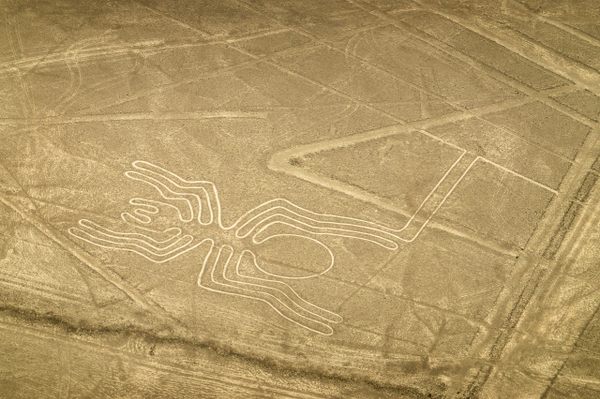To Decipher Peru’s Nazca Lines, Think Like an Ornithologist
Researchers believe the giant birds are more exotic than they seem.

From a bird’s-eye view, the Nazca desert in southern Peru is covered in feathers. Hundreds of gargantuan geoglyphs depicting birds and other creatures speckle the plateau, some as large as two-and-a-half football fields. They’re so large that they can only be seen from hundreds of feet in the air, meaning the pre-Columbian people who drew them would never have had a chance to survey their work. These etchings, called the Nazca Lines, have stumped everyone who sought to understand them, from archaeologists and anthropologists to astronomers and even UFO enthusiasts. Now, a multidisciplinary group of researchers have taken their own, ornithological approach to considering these geoglyphs, according to a study published on June 19, 2019, in the Journal of Archaeological Science: Reports.
The Nazca people created the lines sometime between the fourth century B.C. to the 10th century A.D. While the geoglyphs represent a vast array of creatures such as monkeys and mythical beasts, birds dominate the group. To decipher them, the researchers needed to bird on a prehistoric, monumental scale. In the past, scientists studying the lines identified them as different species of birds, including two hummingbirds, a duck, a flamingo, and a long-tailed mockingbird, according to the study. But these assumptions were based on just a few traits, and the researchers claim there are some notable inconsistencies.
The researchers compared the morphological traits of 16 geoglyphs in Nazca and Pampas de Jumana to characteristics of modern birds living in Peru. This close analysis revealed a number of discrepancies between the birds’ geoglyphic characteristics and the taxonomic groups in which scientists previously placed them. In other words, the geoglyphic birds didn’t actually look much like their supposed real-life counterparts.

Consider the geoglyph formerly thought to be a hummingbird. Past scholars identified it as such because of its long bill, long tail, and short legs. But Peruvian hummingbirds have tails that are forked or fan-shaped. The researchers suggest reclassifying this geoglyph as a hermit (a subgroup of hummingbirds found in the tropics). Hermits boast long bills, short legs, and long, pointed tails—just as portrayed in the geoglyph.
The group made other corrections, reclassifying two geoglyphs—one identified as a guano bird and the other, quite vaguely, as “a bird”—as pelicans. Most of the birds they identified in the lines were exotic, found in coastal places far from the plateau. According to the study author Masaki Eda, a zooarchaeologist at Hokkaido University, these foreign origins must mean something. “If exotic/non local birds were not significant for the Nasca people, there are no reason to draw their geoglyph,” Eda told Newsweek. “So, their existence should be closely related to the purpose of etching geoglyphs. But the reason is difficult to answer.”
Next, the researchers plan to take their work to Nazca temples. There, they’ll compare the morphology of the geoglyphs to birds drawn on ceramics and other painted vessels, which can thankfully be observed from just a few feet above the ground.
















Follow us on Twitter to get the latest on the world's hidden wonders.
Like us on Facebook to get the latest on the world's hidden wonders.
Follow us on Twitter Like us on Facebook